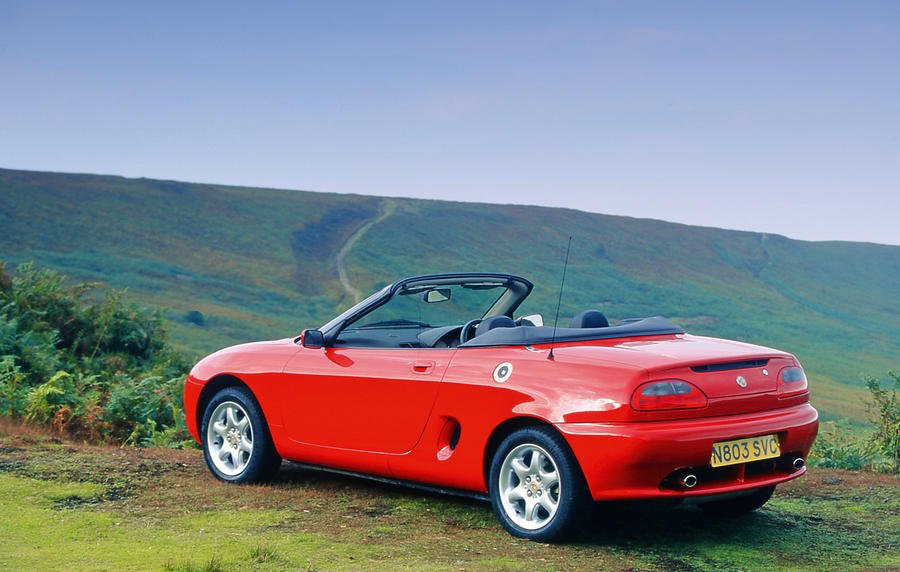In a market swamped with compact SUVs, you wouldn’t be blamed for craving a blast in something small, cheap, fun to drive and quick off the line, and the MGF fills this shrinking niche perfectly.
It arrived at an exciting time for diminutive, mid-engined British sports cars as it went toe to toe with the Lotus Elise (even if it was a little-known front-motored Japanese roadster called the Mazda MX-5 that really came to define the segment). The F arrived to high praise in 1995, received a facelift four years later and soldiered on until 2002, when it was replaced by the closely related TF. The MGF, it is worth remembering, also fought off competition from the Audi TT and BMW Z3 to become the UK’s top-selling affordable sports car.
It was initially launched with one engine: a 1.8-litre K-series producing 118bhp. Another 1.8-litre, a variable valve control engine with 145bhp, was added to the range from 1996. The nature of the F’s mid-engined layout and optimal weight distribution enabled the car to deliver engaging, precise handling, while an innovative Hydragas suspension setup gave a class-challenging ride. All engines were fitted with a PG1 five-speed manual transmission before the introduction of a Steptronic automatic arrived as part of a 1999 facelift. This brought Formula 1-style paddle shifts but contributed to reduced performance and was not as popular as its manual counterparts.
The facelift also ushered in a cabin redesign, with an updated centre console, new comfort-oriented seats, alloy or optional wood door inserts, and improved switchgear to counteract long-voiced criticisms of its build quality, which had tainted its character since launch. New alloy wheel options were offered, too.
A new entry-level 1.6-litre engine was introduced in 2001 with 110bhp, along with the new and exclusive Trophy 160 range-topper, driven by a 1.8-litre VVC engine with 160bhp and capable of 0-62mph in around seven seconds. The Trophy brought two exclusive colours to the F range – Trophy Yellow and Trophy Blue – along with a sports exhaust, bespoke front and rear spoilers and a recalibrated suspension tune. Red brake calipers and larger front brake discs improved stopping power, and the front headlights were reshaped.
A total of 77,269 Fs were built (along with 799 limited models), before its TF replacement arrived with meatier styling and conventional coil-spring suspension. Be wary when scouting for used Fs, as visual differentiation between each variant is minimal. Check the car’s records or documents so you can be sure which model you’re purchasing, and watch out for cambelt wear on vehicles with over 60,000 miles on the clock. Keep an eye out for head gasket failure, specifically with K-series models, and make sure the Hydragas suspension system has been properly maintained to protect against leaks.
Manual options make up a sizeable proportion of used Fs, and you’ll be able to spend anywhere from £500 for a standard car up to £7500 for a well-looked-after Trophy.
How to get one in your garage
An expert's view
Nigel May, Chair, MG Car Club's MGF Register: “The MGF is a great introduction to classic car ownership. For not a lot of money, you can own a mid-engined sports car. Look for signs of rust, particularly on the subframes, and check all electrical items are working. New and used parts are freely available and there are specialists and mobile mechanics around the country who will undertake maintenance if you are not comfortable undertaking work on your own car. On a sunny day with the roof down, you won’t get more smiles per mile for the pounds you’ve spent.”
Buyer beware…
Engine: The engine isn’t particularly accessible, but get digging because it’s important to check for blown gaskets and coolant issues. The cambelt should also be replaced after 60,000 miles or every five years.
Suspension: The MGF’s suspension can degrade over time with wear to ball joints, bearings and dampers between 30,000 and 75,000 miles. Make sure the Hydragas system is free from leaks and hasn’t sunk too low, although this can be refilled.
Spec verification: Thoroughly read any documentation before you buy, as non-Trophy cars are all but identical. For the 1.6-litre, check for matt black, unpainted door handles and side intakes. VIN plates can be found at the bottom of the windscreen, next to the spare wheel and on the right-hand front shock tower.
Corrosion: There are a few problem areas on the MGF for corrosion and rust, including subframes, air intakes, door sills and front wings, which are particularly susceptible. Go all around the car with a fine-tooth comb, particularly if it’s got a high mileage and has been daily-driven at any point.
Also worth knowing
There are a few MGF mechanical experts spread around the UK, including MGF Centre in Wolverhampton (01902 453 100) and Just Right Autos in Witney, Oxfordshire (01993 778060). If you’re unable to travel, Rough Luck Racing (07766 993717), a specialist MG mobile mechanic, can come to you.
How much to spend
£500–£1199: High-mileage project cars with rust and bodywork scrapes. Some gems, such as a 2001-reg 1.8i with a new exhaust and catalytic converter, but work and expense are required on most cars at this price.
£1200–£1999: Some decent examples, including a two-owner manual 1.8i in good general condition with full MOT and just 33,000 miles on the clock.
£2000–£3499: Fine examples of later models from 2001 with regular maintenance, low mileage and history checks. Some owners have spent significantly to bring their cars up to standard.
£3500–£6000: Low-mileage, showroom-quality Trophy Editions that could cost up to £6000. Most at this price have had a new head gasket fitted, but you should still look out for signs of rust and check service histories.

